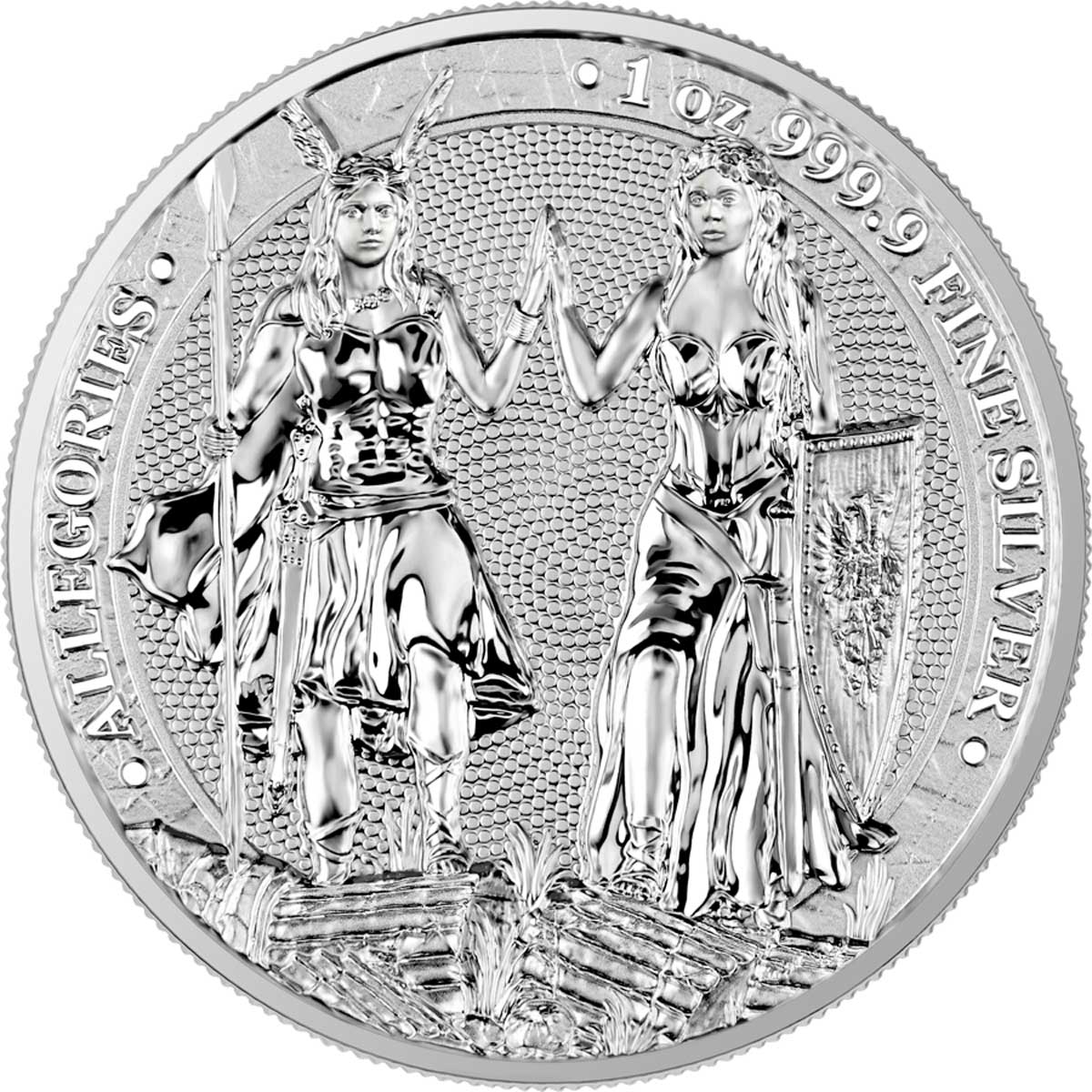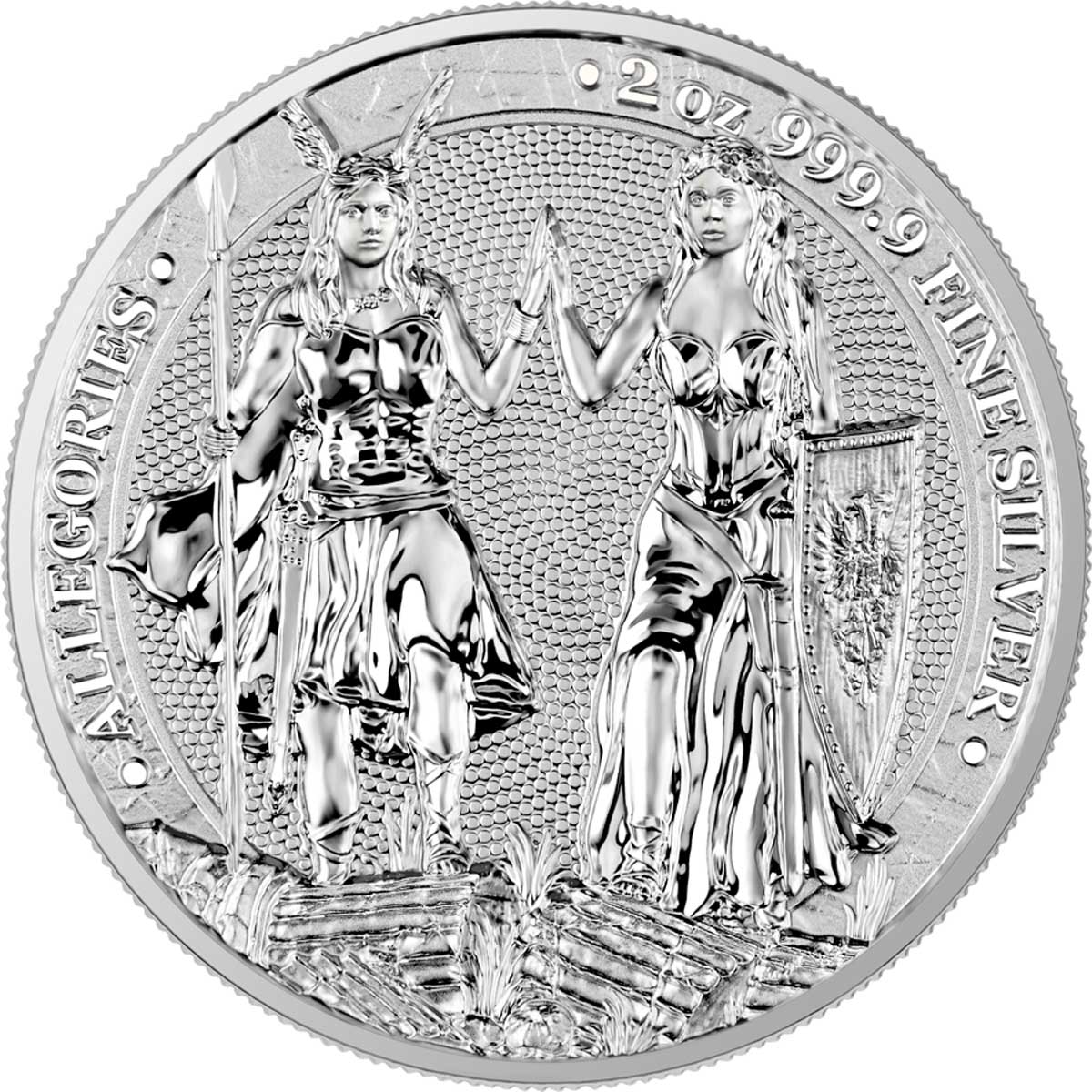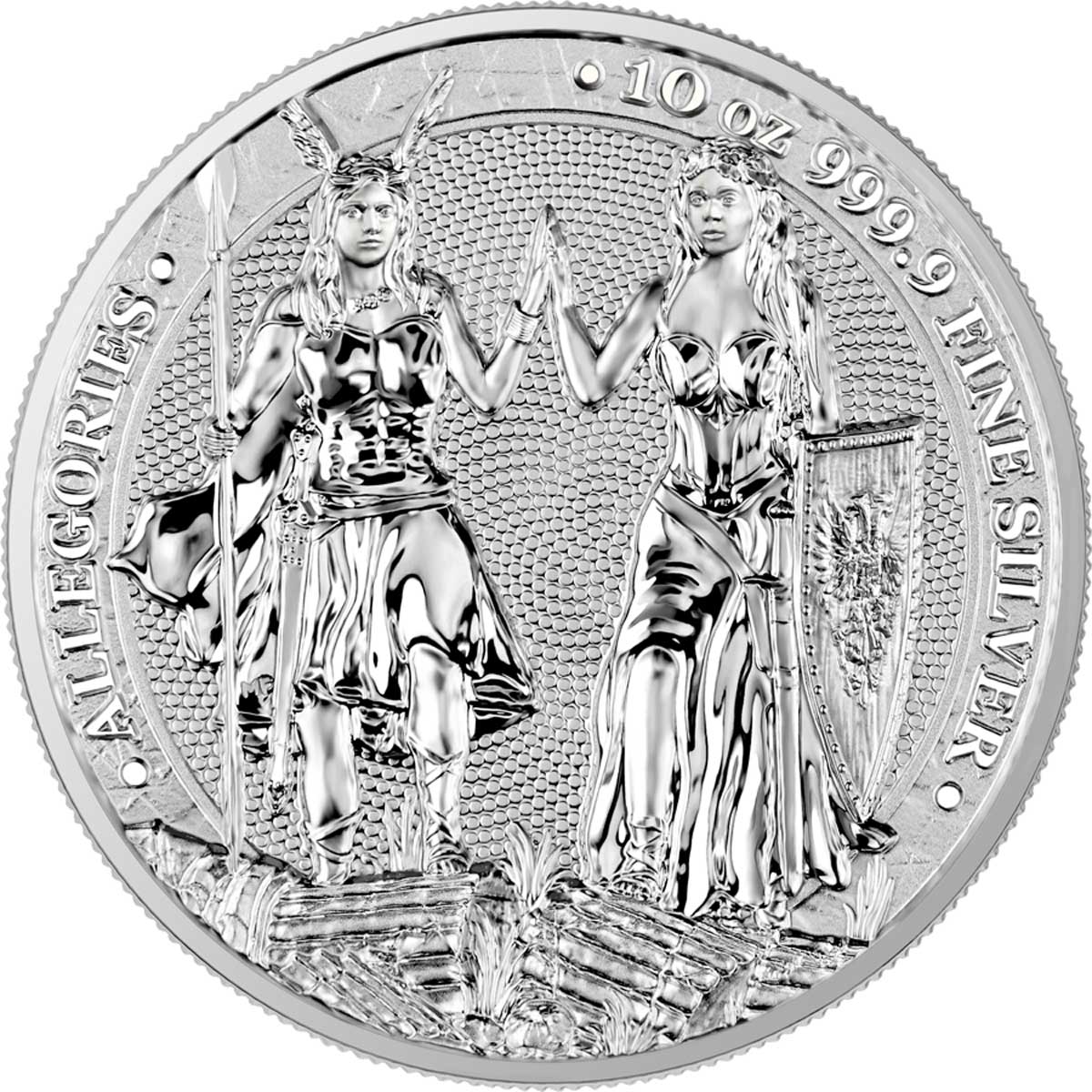Germania Mint concludes its Allegories dual-personification bullion coin series with the French Galia
Sad to see that the Germania Mint is wrapping up it’s pretty ‘Allegories’ series of silver bullion coins after six issues. Probably just behind its flagship ‘Germania’ series for popularity, it took the idea of national female personifications a step further than usual, by standing their own Lady Germania alongside one of a different nation. We’ve had Britain, the US, Italia, Austria and Poland previously, and the series will end with France, more specifically, Galia.
The depiction of Galia is one of the best yet, warlike, and with a winged helmet, looking every inch the warrior. The Lady Germania is attired as we’ve come to expect, and carrying her now iconic shield. They touch hands in the centre of the reverse face, and stand over the remains of a stone column in the Greco-Roman style, perhaps symbolising the end of empire. The guilloche patterned background field returns, as does the gorgeous heraldic obverse common to the series. It’s all beautifully done. We don’t get samples any more, unfortunately, (my fault), but earlier coins have been impeccably struck.
The unusual part of this series has always been the choice of formats. There are one, two, five and ten ounce variants, and rather than taking the ‘Germania’ approach of differing diameters, they’ve gone with a consistent diameter, pouring all that extra metal into thickness, ranging from 3 mm for the 1 oz coin to 25.85 mm for 10 oz. It’s not often mints do this, with only the ‘Bounty’ series immediately coming to mind, but it adds variety to the bullion market, and certainly makes them easier to stack.
However, the three larger coins come individually packaged, and in progressively smaller mintages as the weight increases, so not really a coin for the bulk stacker, outside the standard encapsulated one-ounce coin. Whatever the case, an attractive way to end a classic coin series, and we, for one, are sad to see it go. We’re looking forward to seeing what comes next. You can see more of this series in our Bullion Series Profile of Allegories, and the wider Germania world in our summary round-up.




MINTS DESCRIPTION
Galia and Germania share a common history of being inhabited by other tribes and confronting the Roman Empire.
The obverse of the coin depicts the personifications of Galia and Germania, shown as young and beautiful women. They stand together, joining their hands as a sign of victory. Their swords are sheathed after the battle and the debris of the defeated Roman Empire lies beneath their feet.
In the artistic vision of the Germania Mint project, Galia is clad in a Roman breastplate and sandals that indicate the intermingling of cultures, enforced by the need to cooperate with the occupying power. In her hand she wields a Gaulish spear and on her head is a distinctive Gaulish diadem with wings. 0Germania’s head is adorned with an oak branch – a tree that has accompanied her since the beginning of the series. In her hand, she holds a shield with the image of a two-headed eagle.
According to the previous series, the image on the reverse is the coat of arms representing moral principles and noble values. Germania was a historical land and has never been an official country, that’s why we’ve decided to create our own interpretation of its coat of arms. Its symbols and design are a Creative tion of our imagination, however it has been created in accordance with applicable heraldry rules.
The crowned shield has been divided into four parts, from which each has a traditional meaning, precisely defined by heraldry. The shield itself is a symbol of truth, loyalty and trust. The crown equals authority and nobility as well as chivalry.
Germania Mint’s visualisation of the Bicephalous eagle – a Roman mythology symbol associated with Janus, god of all origins, guardian of doors, gates, passages and bridges, patron of contracts and alliances. Heads facing opposite sides symbolize the past and the future. The check pattern refers to wisdom and prudence – characteristics of every noble sovereign.
The gold ribbon with three flowers. Flowers represent determining values of a strong and independent nation – unity, integrity and freedom.The wild boar symbol of mightiness was a very popular and respectful animal in Roman Empire. Legio I Italica, Legio X Fretensis and Legio XX Valeria Victrix are three of the most famous Roman legions with boar in their emblem.
The Coat of Arms is surrounded by the wreath of oak leaves. Wreath symbolizes loyalty, stability and national unity. In Mythology and ancient times only people who wielded enormous power – spirit, muscle or magic – were allowed to wear it. All values presented in symbolism above, were respected by Germania and Polonia.
| SPECIFICATION | |||||
| DENOMINATION | COMPOSITION | SIZE | FINISH | MINTAGE | |
| 5 Marks (faux) | 31.1 g of 0.9999 silver | 38.61 mm | Brilliant Uncirculated | 25,000 | |
| 10 Marks (faux) | 62.2 g of 0.9999 silver | 38.61 mm | Brilliant Uncirculated | 2,500 | |
| 25 Marks (faux) | 155.5 g of 0.9999 silver | 38.61 mm | Brilliant Uncirculated | 500 | |
| 50 Marks (faux) | 311.0 g of 0.9999 silver | 38.61 mm | Brilliant Uncirculated | 250 | |




Thanks Mik for the update ! I thought I read, after the first issue (Britannia & Germania) that the series would have 12 issues. Is Germania mint short cutting the series to 6 ? Or have I read or remembered it wrong (lol), greetings T
Yes, the series is now finished. I don’t know why, to be honest. There were no proof or gold versions in the range, so perhaps the focus on silver bullion only, with comparatively small mintages, has become less viable these days. I really don’t know. Shame though.
Thanks for the reply Mik !